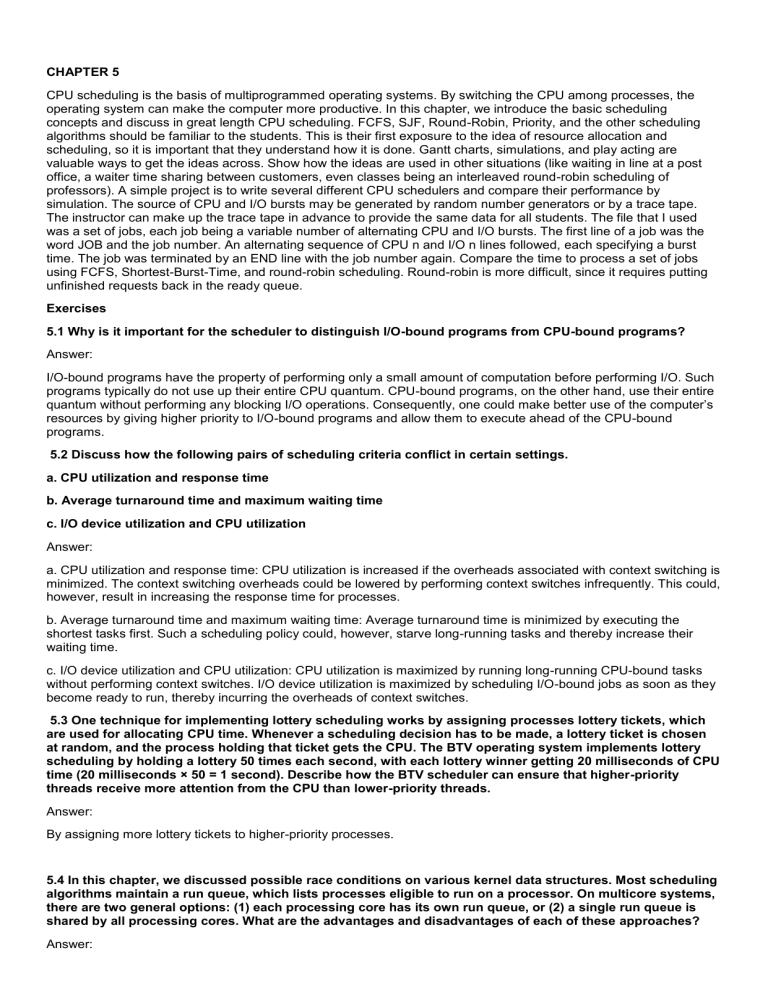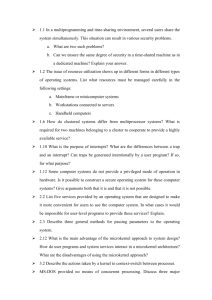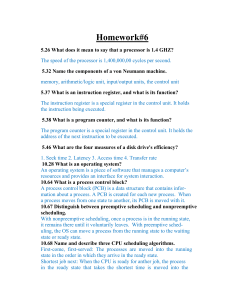
CHAPTER 5 CPU scheduling is the basis of multiprogrammed operating systems. By switching the CPU among processes, the operating system can make the computer more productive. In this chapter, we introduce the basic scheduling concepts and discuss in great length CPU scheduling. FCFS, SJF, Round-Robin, Priority, and the other scheduling algorithms should be familiar to the students. This is their first exposure to the idea of resource allocation and scheduling, so it is important that they understand how it is done. Gantt charts, simulations, and play acting are valuable ways to get the ideas across. Show how the ideas are used in other situations (like waiting in line at a post office, a waiter time sharing between customers, even classes being an interleaved round-robin scheduling of professors). A simple project is to write several different CPU schedulers and compare their performance by simulation. The source of CPU and I/O bursts may be generated by random number generators or by a trace tape. The instructor can make up the trace tape in advance to provide the same data for all students. The file that I used was a set of jobs, each job being a variable number of alternating CPU and I/O bursts. The first line of a job was the word JOB and the job number. An alternating sequence of CPU n and I/O n lines followed, each specifying a burst time. The job was terminated by an END line with the job number again. Compare the time to process a set of jobs using FCFS, Shortest-Burst-Time, and round-robin scheduling. Round-robin is more difficult, since it requires putting unfinished requests back in the ready queue. Exercises 5.1 Why is it important for the scheduler to distinguish I/O-bound programs from CPU-bound programs? Answer: I/O-bound programs have the property of performing only a small amount of computation before performing I/O. Such programs typically do not use up their entire CPU quantum. CPU-bound programs, on the other hand, use their entire quantum without performing any blocking I/O operations. Consequently, one could make better use of the computer’s resources by giving higher priority to I/O-bound programs and allow them to execute ahead of the CPU-bound programs. 5.2 Discuss how the following pairs of scheduling criteria conflict in certain settings. a. CPU utilization and response time b. Average turnaround time and maximum waiting time c. I/O device utilization and CPU utilization Answer: a. CPU utilization and response time: CPU utilization is increased if the overheads associated with context switching is minimized. The context switching overheads could be lowered by performing context switches infrequently. This could, however, result in increasing the response time for processes. b. Average turnaround time and maximum waiting time: Average turnaround time is minimized by executing the shortest tasks first. Such a scheduling policy could, however, starve long-running tasks and thereby increase their waiting time. c. I/O device utilization and CPU utilization: CPU utilization is maximized by running long-running CPU-bound tasks without performing context switches. I/O device utilization is maximized by scheduling I/O-bound jobs as soon as they become ready to run, thereby incurring the overheads of context switches. 5.3 One technique for implementing lottery scheduling works by assigning processes lottery tickets, which are used for allocating CPU time. Whenever a scheduling decision has to be made, a lottery ticket is chosen at random, and the process holding that ticket gets the CPU. The BTV operating system implements lottery scheduling by holding a lottery 50 times each second, with each lottery winner getting 20 milliseconds of CPU time (20 milliseconds × 50 = 1 second). Describe how the BTV scheduler can ensure that higher-priority threads receive more attention from the CPU than lower-priority threads. Answer: By assigning more lottery tickets to higher-priority processes. 5.4 In this chapter, we discussed possible race conditions on various kernel data structures. Most scheduling algorithms maintain a run queue, which lists processes eligible to run on a processor. On multicore systems, there are two general options: (1) each processing core has its own run queue, or (2) a single run queue is shared by all processing cores. What are the advantages and disadvantages of each of these approaches? Answer: The primary advantage of each processing core having its own run queue is that there is no contention over a single run queue when the scheduler is running concurrently on 2 or more processors. When a scheduling decision must be made for a processing core, the scheduler only need to look no further than its private run queue. A disadvantage of a single run queue is that it must be protected with locks to prevent a race condition and a processing core may be available to run a thread, yet it must first acquire the lock to retrieve the thread from the single queue. However, load balancing would likely not be an issue with a single run queue, whereas when each processing core has its own run queue, there must be some sort of load balancing between the different run queues. 5.5 Consider the exponential average formula used to predict the length of the next CPU burst. What are the implications of assigning the following values to the parameters used by the algorithm? a. α = 0 and τ0 = 100 milliseconds b. α = 0.99 and τ 0 = 10 milliseconds Answer: When α = 0 and τ0 = 100 milliseconds, the formula always makes a prediction of 100 milliseconds for the next CPU burst. When α = 0.99 and τ0 = 10 milliseconds, the most recent behavior of the process is given much higher weight than the past history associated with the process. Consequently, the scheduling algorithm is almost memoryless, and simply predicts the length of the previous burst for the next quantum of CPU execution. 5.6 A variation of the round-robin scheduler is the regressive round-robin scheduler. This scheduler assigns each process a time quantum and a priority. The initial value of a time quantum is 50 milliseconds. However, every time a process has been allocated the CPU and uses its entire time quantum (does not block for I/O), 10 milliseconds is added to its time quantum, and its priority level is boosted. (The time quantum for a process can be increased to a maximum of 100 milliseconds.) When a process blocks before using its entire time quantum, its time quantum is reduced by 5 milliseconds, but its priority remains the same. What type of process (CPU-bound or I/O-bound) does the regressive round-robin scheduler favor? Explain. Answer: This scheduler would favor CPU-bound processes as they are rewarded with a longer time quantum as well as priority boost whenever they consume an entire time quantum. This scheduler does not penalize I/O-bound processes as they are likely to block for I/O before consuming their entire time quantum, but their priority remains the same. 5.9 The nice command is used to set the nice value of a process on Linux, as well as on other UNIX systems. Explain why some systems may allow any user to assign a process a nice value >= 0 yet allow only the root user to assign nice values < 0. Answer: Nice values < 0 are assigned a higher relative priority and such systems may not allow non-root processes to assign themselves higher priorities. 5.10 Which of the following scheduling algorithms could result in starvation? a. First-come, first-served b. Shortest job first c. Round robin d. Priority Answer: Shortest job first and priority-based scheduling algorithms could result in starvation. 5.11 Consider a variant of the RR scheduling algorithm where the entries in the ready queue are pointers to the PCBs. a. What would be the effect of putting two pointers to the same process in the ready queue? b. What would be two major advantages and disadvantages of this scheme? c. How would you modify the basic RR algorithm to achieve the same effect without the duplicate pointers? Answer: a. In effect, that process will have increased its priority since by getting time more often it is receiving preferential treatment. b. The advantage is that more important jobs could be given more time, in other words, higher priority in treatment. The consequence, of course, is that shorter jobs will suffer. c. Allot a longer amount of time to processes deserving higher priority. In other words, have two or more quantums possible in the Round-Robin scheme. 5.12 Consider a system running ten I/O-bound tasks and one CPU-bound task. Assume that the I/O-bound tasks issue an I/O operation once for every millisecond of CPU computing and that each I/O operation takes 10 milliseconds to complete. Also assume that the context-switching overhead is 0.1 millisecond and that all processes are long-running tasks. Describe is the CPU utilization for a round-robin scheduler when: a. The time quantum is 1 millisecond b. The time quantum is 10 milliseconds Answer: a. The time quantum is 1millisecond: Irrespective of which process is scheduled, the scheduler incurs a 0.1 millisecond context-switching cost for every context-switch. This results in a CPU utilization of 1/1.1 * 100 = 91%. b. The time quantum is 10 milliseconds: The I/O-bound tasks incur a context switch after using up only 1 millisecond of the time quantum. The time required to cycle through all the processes is therefore 10*1.1 + 10.1 (as each I/Obound task executes for 1 millisecond and then incur the context switch task, whereas the CPU-bound task executes for 10 milliseconds before incurring a context switch). The CPU utilization is therefore 20/21.1 * 100 = 94%. 5.13 Consider a system implementing multilevel queue scheduling. What strategy can a computer user employ to maximize the amount of CPU time allocated to the user’s process? Answer: The program could maximize the CPU time allocated to it by not fully utilizing its time quantums. It could use a large fraction of its assigned quantum, but relinquish the CPU before the end of the quantum, thereby increasing the priority associated with the process. 5.14 Consider a preemptive priority scheduling algorithm based on dynamically changing priorities. Larger priority numbers imply higher priority. When a process is waiting for the CPU (in the ready queue, but not running), its priority changes at a rate α; when it is running, its priority changes at a rate β. All processes are given a priority of 0 when they enter the ready queue. The parameters α and β can be set to give many different scheduling algorithms. a. What is the algorithm that results from β > α > 0? b. What is the algorithm that results from α < β < 0? Answer: a. FCFS b. LIFO 5.15 Explain the differences in how much the following scheduling algorithms discriminate in favor of short processes: a. FCFS b. RR c. Multilevel feedback queues Answer: a. FCFS—discriminates against short jobs since any short jobs arriving after long jobs will have a longer waiting time. b. RR—treats all jobs equally (giving them equal bursts of CPU time) so short jobs will be able to leave the system faster since they will finish first. c. Multilevel feedback queues work similar to the RR algorithm—they discriminate favorably toward short jobs. 5.16 Using the Windows scheduling algorithm, determine the numeric priority of each of the following threads a. A thread in the REALTIME_PRIORITY_CLASS with a relative priority of HIGHEST. b. A thread in the NORMAL_PRIORITY_CLASS with a relative priority of NORMAL. c. A thread in the HIGH_PRIORITY_CLASS with a relative priority of ABOVE_NORMAL. Answer: a. 26 b. 8 c. 14 5.17 Assuming that no threads belong to the REALTIME_PRIORITY_CLASS and that none may be assigned a TIME_CRITICAL priority, what combination of priority class and priority corresponds to the highest possible relative priority in Windows scheduling? Answer: HIGH priority class and HIGHEST priority within that class. (numeric priority of 15) 5.18 Consider the scheduling algorithm in the Solaris operating system for time-sharing threads: a. What is the time quantum (in milliseconds) for a thread with priority 10? With priority 55? b. Assume a thread with priority 35 has used its entire time quantum without blocking. What new priority will the scheduler assign this thread? c. Assume a thread with priority 35 blocks for I/O before its time quantum has expired. What new priority will the scheduler assign this thread? Answer: a. 160 and 40 b. 35 c. 54 5.19 Assume that two tasks A and B are running on a Linux system. The nice values of A and B are−5 and+5, respectively. Using the CFS scheduler as a guide, describe how the respective values of vruntime vary between the two processes given each of the following scenarios: • Both A and B are CPU-bound. • A is I/O-bound, and B is CPU-bound. • A is CPU-bound, and B is I/O-bound. Answer: • Since A has a higher priority than B, vruntime will move more slowly for A than B. If both A and B are CPU-bound (that is they both use the CPU for as long as it is allocated to them), vruntime will generally be smaller for A than B, and hence A will have a greater priority to run over B. • In this situation, vruntime will be much smaller for A than B as (1) vruntime will move more slowly for A than B due to priority differences, and (2) Awill require less CPU-time as it is I/O-bound. • This situation is not as clear, and it is possible that B may end up running in favor of A as it will be using the processor less than A and in fact its value of vruntime may in fact be less than the value of vruntime for B. 5.20 Discuss ways in which the priority inversion problem could be addressed in a real-time system. Also discuss whether the solutions could be implemented within the context of a proportional share scheduler. Answer: The priority inversion problem could be addressed by temporarily changing the priorities of the processes involved. Processes that are accessing resources needed by a higher-priority process inherit the higher priority until they are finished with the resources in question. When they are finished, their priority reverts to its original value. This solution can be easily implemented within a proportional share scheduler; the shares of the high-priority processes are simply transferred to the lower-priority process for the duration when it is accessing the resources. 5.21 Under what circumstances is rate-monotonic scheduling inferior to earliest-deadline-first scheduling in meeting the deadlines associated with processes? Answer: Consider two processes P1 and P2 where p1 = 50, t1 = 25 and p2 = 75, t2 = 30. If P1 were assigned a higher priority than P2, then the following scheduling events happen under rate-monotonic scheduling. P1 is scheduled at t = 0, P2 is scheduled at t = 25, P1 is scheduled at t = 50, and P2 is scheduled at t = 75. P2 is not scheduled early enough to meet its deadline. The earliest deadline schedule performs the following scheduling events: P1 is scheduled at t = 0, P2 is scheduled at t = 25, P1 is scheduled at t = 55, and so on. This schedule actually meets the deadlines and therefore earliest-deadline-first scheduling is more effective than the rate-monotonic scheduler. 5.22 Consider two processes, P1 and P2, where p1 = 50, t1 = 25, p2 = 75, and t2 = 30. a. Can these two processes be scheduled using rate-monotonic scheduling? Illustrate your answer using a Gantt chart such as the ones in Figure 5.16–Figure 5.19. b. Illustrate the scheduling of these two processes using earliest-deadline-first (EDF) scheduling. Answer: Consider when P1 is assigned a higher priority than P2 with the rate monotonic scheduler. P1 is scheduled at t = 0, P2 is scheduled at t = 25, P1 is scheduled at t = 50, and P2 is scheduled at t = 75. P2 is not scheduled early enough to meet its deadline. When P1 is assigned a lower priority than P2, then P1 does not meet its deadline since it will not be scheduled in time. 5.23 Explain why interrupt and dispatch latency times must be bounded in a hard real-time system. Answer: following tasks: save the currently executing instruction, determine the type of interrupt, save the current process state, and then invoke the appropriate interrupt service routine. Dispatch latency is the cost associated with stopping one process and starting another. Both interrupt and dispatch latency needs to be minimized in order to ensure that real-time tasks receive immediate attention. Furthermore, sometimes interrupts are disabled when kernel data structures are being modified, so the interrupt does not get serviced immediately. For hard real-time systems, the time-period for which interrupts are disabled must be bounded in order to guarantee the desired quality of service.




